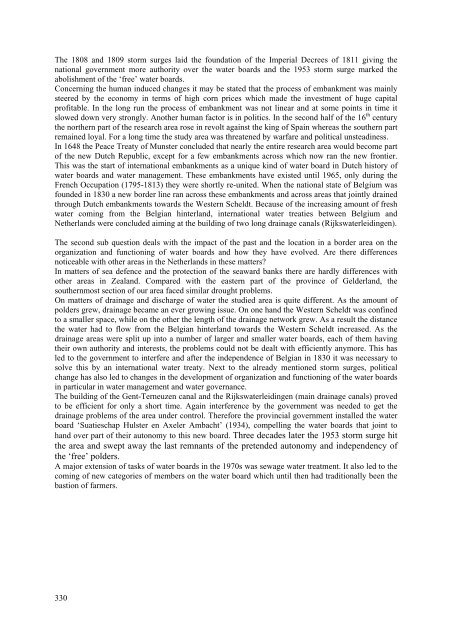Bibliografie - VU-DARE Home
Bibliografie - VU-DARE Home
Bibliografie - VU-DARE Home
Create successful ePaper yourself
Turn your PDF publications into a flip-book with our unique Google optimized e-Paper software.
The 1808 and 1809 storm surges laid the foundation of the Imperial Decrees of 1811 giving the<br />
national government more authority over the water boards and the 1953 storm surge marked the<br />
abolishment of the ‘free’ water boards.<br />
Concerning the human induced changes it may be stated that the process of embankment was mainly<br />
steered by the economy in terms of high corn prices which made the investment of huge capital<br />
profitable. In the long run the process of embankment was not linear and at some points in time it<br />
slowed down very strongly. Another human factor is in politics. In the second half of the 16 th century<br />
the northern part of the research area rose in revolt against the king of Spain whereas the southern part<br />
remained loyal. For a long time the study area was threatened by warfare and political unsteadiness.<br />
In 1648 the Peace Treaty of Munster concluded that nearly the entire research area would become part<br />
of the new Dutch Republic, except for a few embankments across which now ran the new frontier.<br />
This was the start of international embankments as a unique kind of water board in Dutch history of<br />
water boards and water management. These embankments have existed until 1965, only during the<br />
French Occupation (1795-1813) they were shortly re-united. When the national state of Belgium was<br />
founded in 1830 a new border line ran across these embankments and across areas that jointly drained<br />
through Dutch embankments towards the Western Scheldt. Because of the increasing amount of fresh<br />
water coming from the Belgian hinterland, international water treaties between Belgium and<br />
Netherlands were concluded aiming at the building of two long drainage canals (Rijkswaterleidingen).<br />
The second sub question deals with the impact of the past and the location in a border area on the<br />
organization and functioning of water boards and how they have evolved. Are there differences<br />
noticeable with other areas in the Netherlands in these matters?<br />
In matters of sea defence and the protection of the seaward banks there are hardly differences with<br />
other areas in Zealand. Compared with the eastern part of the province of Gelderland, the<br />
southernmost section of our area faced similar drought problems.<br />
On matters of drainage and discharge of water the studied area is quite different. As the amount of<br />
polders grew, drainage became an ever growing issue. On one hand the Western Scheldt was confined<br />
to a smaller space, while on the other the length of the drainage network grew. As a result the distance<br />
the water had to flow from the Belgian hinterland towards the Western Scheldt increased. As the<br />
drainage areas were split up into a number of larger and smaller water boards, each of them having<br />
their own authority and interests, the problems could not be dealt with efficiently anymore. This has<br />
led to the government to interfere and after the independence of Belgian in 1830 it was necessary to<br />
solve this by an international water treaty. Next to the already mentioned storm surges, political<br />
change has also led to changes in the development of organization and functioning of the water boards<br />
in particular in water management and water governance.<br />
The building of the Gent-Terneuzen canal and the Rijkswaterleidingen (main drainage canals) proved<br />
to be efficient for only a short time. Again interference by the government was needed to get the<br />
drainage problems of the area under control. Therefore the provincial government installed the water<br />
board ‘Suatieschap Hulster en Axeler Ambacht’ (1934), compelling the water boards that joint to<br />
hand over part of their autonomy to this new board. Three decades later the 1953 storm surge hit<br />
the area and swept away the last remnants of the pretended autonomy and independency of<br />
the ‘free’ polders.<br />
A major extension of tasks of water boards in the 1970s was sewage water treatment. It also led to the<br />
coming of new categories of members on the water board which until then had traditionally been the<br />
bastion of farmers.<br />
330

















